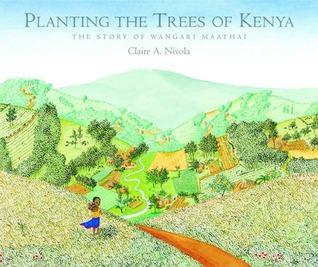
Planting the Trees of Kenya
Read Aloud Book: Planting the Trees of Kenya
Story: Claire A Nivola
Illustration: Claire A Nivola
ISBN-13: 978-0374399184
C3 Framework Key term: Modify an environment: Human actions that change natural elements and/or physical systems.
Synopsis
Wangari Maathai grew up in the countryside of Kenya, which was covered in trees and plants. She went away to America for college and studied biology. She learned to always think about what she could do for the world. When she returned home after five years, all of the trees had been cut down and the small family farms and tea plantations had been replaced by large crop plantations and the rivers had dried up and become polluted by silt. The people had become very sickly from these changes and Wangari knew the solution was to bring back the trees. She empowered all the women to plant trees and small gardens for food. At first it was difficult but soon the trees and plants were thriving and the people were healthy again. Wangari traveled all over Kenya and spread her message to school children, inmates, and even soldiers. When she was done, Kenya was covered in trees again.
Discussion
Say: Wangari Maathai was the first woman from Africa to receive the Nobel Peace Prize for her work connecting the health of the environment in Kenya to the health of the people. Thirty years after Wangari started her mission to replant the trees of Kenya more than thirty million trees have been planted. Ask: What motivated Wangari to start encouraging people to plant trees again? How does the book describe Wangari? Why is this important? Why do you think Wangari started with the women of the villages? How did planting the trees improve the lives of the people of Kenya?
Ethics Connection
Say: When governments do not take action to reduce gaps in standards of living, individuals and non-government organizations (NGOs – groups not associated with business or governmental interests) can find ways to support people. In Kenya, cutting the trees led to “environmental degradation.” Being a marginalized group, women were especially vulnerable to this impact for several reasons including loss of agricultural income-generating activities and women’s lack of access to alternative workplaces. Also, women in many developing countries have deep knowledge of ecosystems and the fragility of these systems. Write on the board: Women’s contribution to conservation and management of natural resources. Say: In groups, create a short speech to a government agency. In your speech, argue for increasing the number of women representatives invited to advise policies that safeguard the environment, including policies to assess hazards, design solutions, and fund the implementation of environmental conservation and restoration programs.
Fun Activity
Say: Responsible tree planting actions should use local trees that meet the needs of the community. Look up the image of one of the following trees and draw the tree. Note the tree’s name and use at the top of the page. Provide the tree list: (1) Casuarina equisetifolia (good for fences and firewood); (2) Croton megalocarpus (helps repair soil by providing nutrients. Provides shade). (3) Syzygium guineense (water pear; provides edible fruit). (4) Spathodea companulata (African tulip tree; used for medical treatment of multiple conditions including kidney disease, and stomach problems.